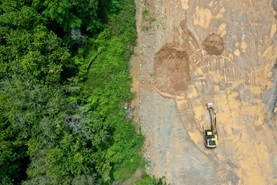Scope 3 Supply Chain Emissions: Five Questions Investors Need to Know
To assess climate-related transition risks, investors should evaluate GHG emissions across portfolio companies’ value chains. In this blog post we’ll answer the key questions investors need to know about supply chain GHG emissions, and why decarbonization of the supply chain is an essential component of an effective climate transition strategy.
Managing Risks for a Changing Climate: A Guide for Institutional Investors
Gain a better understanding of physical and transition climate risks and their potential impacts to effectively respond to climate risks in investment portfolios and comply with the growing list of climate-focused reporting frameworks and regulations.
Capturing the Direct and Indirect Risks of Physical Climate Change in Investment Portfolios
Investors face a unique set of challenges in assessing the physical climate risks affecting their portfolio companies. In this blog discover the direct and indirect physical climate risks impacting companies and their supply chains.
A New Tool at the Table: Understanding Low Carbon Transition Risk By Industry and How Companies Are Managing It
Discover how leading companies are managing their low carbon transition risks. Using data from the Low Carbon Transition Ratings, we identify the industries with a large portion of the companies with strong management of transition issues and examine the factors contributing to their strong management scores.
Carbon Emissions Data for Investors: Closing the Reporting Gap and Future-Proofing Estimations
Despite improvements in the quality and quantity of carbon emissions reporting from companies, significant gaps remain. Discover the current state of emissions disclosures, learn the advantages and disadvantages of widely used estimation models, and discover the approach underpinning Sustainalytics' Carbon Emissions Data product.
Investors Seek Meaningful Scope 3 Emissions Targets to Evaluate Climate Transition Plans
Climate concerns continued to dominate proxy voting in the 2022 proxy season. With more clarity on sectoral commitments required to achieve the global net zero goal, shareholders’ requests have become noticeably more specific. A larger number of resolutions asked companies to adopt and report on emissions reduction targets and transition plans that reference the latest forward-looking guidance.
Post-COP15 Outlook: Evolving Investor Responsibilities in Biodiversity
Awaiting COP15’s Global Biodiversity Framework negotiation outcomes, financial market participants could face new regulatory pressure sooner than expected to integrate biodiversity assessment into their investment, decision-making processes.
Danish Delegation Engages Sustainalytics’ Biodiversity Expert, Enabling Front Row Access to COP15 Negotiations
Finance Day within the U.N. Biodiversity Conference (COP15) is fast approaching, and Morningstar Sustainalytics’ team members will be in attendance, each focusing on different investor biodiversity considerations related to active ownership.
Physical Climate Risk: Preparing Your Portfolio for a Changing Climate
The physical climate risks affecting assets are likely to increase in the coming years, as the impacts of climate change are felt more frequently and with more intensity. In this guide, learn how companies and investors can assess their exposure to physical climate risks.
The Role of Sustainable Aviation Fuel in Achieving Decarbonization by 2050
Meeting the aviation's industry's goal of decarbonization by 2050 will require a collective effort and more ambitious measures than those currently in place, including carbon offsetting, route optimization, fuel efficiency and fleet renewals that involve a shift to more eco-friendly aircraft. However, all of these measures still revolve around fossil fuels as a source of energy.
Physical Climate Risks: 6 Things Portfolio Managers Need to Know
The negative physical impacts of climate change are being felt by communities and corporations globally and are likely to get worse in the coming years. The knock-on costs of more frequent “once-in-a-century” climate events on economies are likely to rise. To prepare for this looming threat, investors must forecast the asset-level effects of climate change on companies in a granular and sophisticated way. Here are six things portfolio managers should know to manage and mitigate the physical risks of climate change to their portfolios and meet growing list of climate-focused reporting requirements.
Impact of US Supreme Court’s EPA Ruling on US Utilities’ Carbon Exposure
The Clean Power Plan was created using a directive from the Clean Air Act that enabled the EPA to set emission limits for air pollutants based on the best available technology to reduce emissions. The EPA aimed to cap carbon emissions and curb greenhouse (GHG) emissions by changing the composition of the existing operational power generation assets by forcing the closure of coal plants through strict emission caps, resulting in a system-wide transition to renewable energy.
How Europe’s Energy Crisis Impacts the Clean Energy Transition
Europe is facing two major crises—an energy crisis, worsened by Russian energy supply disruptions and the challenge of tackling climate change. Renewables have the potential to accelerate EU's energy independence and reduce emissions. Still, there is also an urgent need to secure an adequate energy supply, especially in the coming winter months when heating demand increases. In the short-term, many EU countries are turning to other fossil fuel producers in the Middle East OPEC+ and the US, as well as domestic coal production. For firms deciding which energy projects to invest in, they face a complex question: are energy supply disruptions advancing the EU’s transition to a lower-carbon economy and its energy independence or furthering the continent’s dependence on fossil fuels?
Biodiversity loss and climate change call for a nature-positive economy – Stewardship may lead the way
Financial institutions funding the supply chains affected by biodiversity loss stand to lose right alongside farmers, producers and retailers—and so, in turn, do investors. ESG stewardship continues to be a powerful investor instrument to mitigate risks on a changing planet. With growing expectations of double materiality, it is an opportunity for investors to have a greater societal impact and support the transition towards a nature-positive economy.










.png?sfvrsn=2eecdd86_0)









